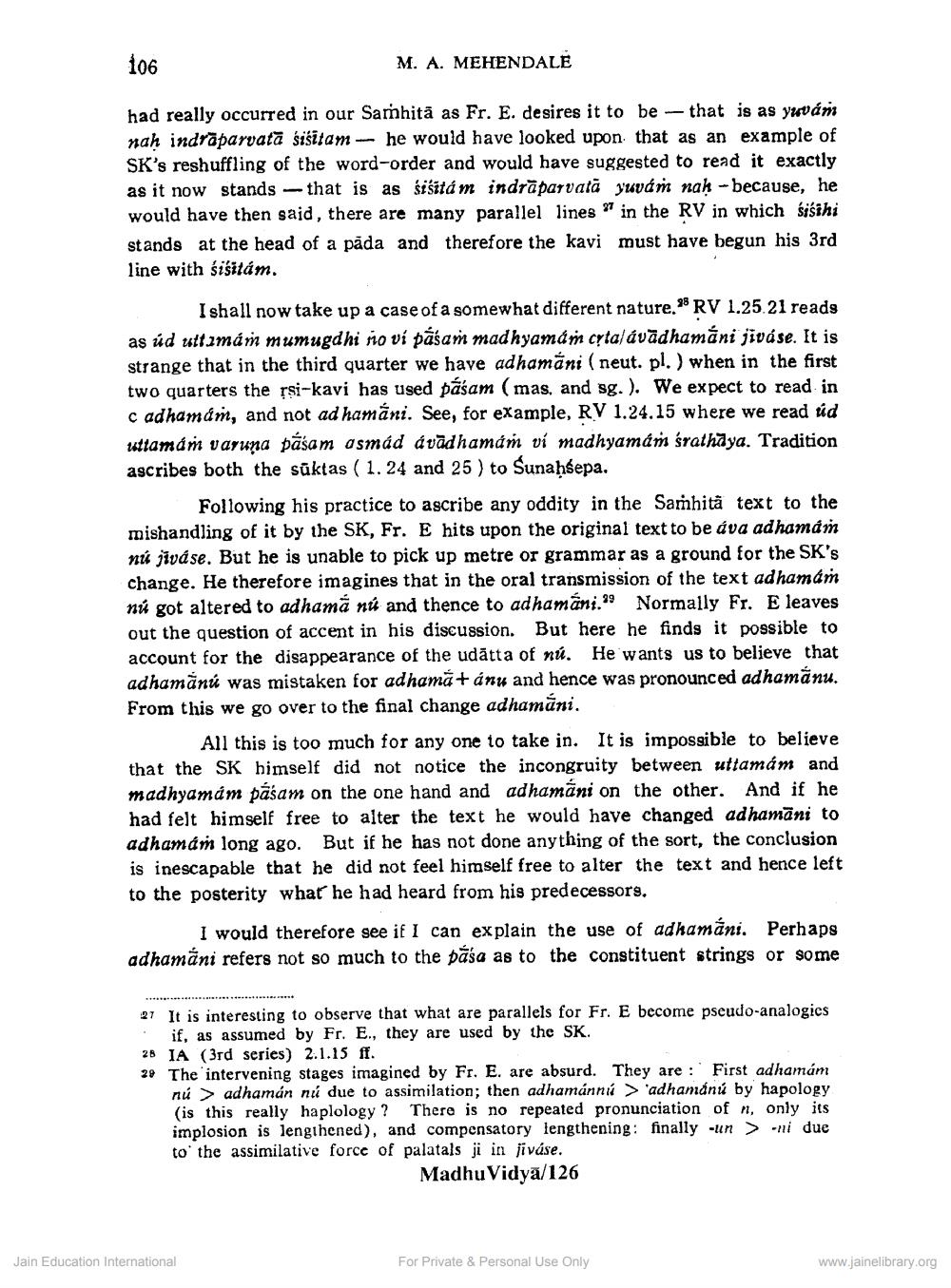________________
106
M. A. MEHENDALE
had really occurred in our Samhitã as Fr. E. desires it to be - that is as yuván nah indrāparvatā śiśitam - he would have looked upon that as an example of SK's reshuffling of the word-order and would have suggested to read it exactly as it now stands -- that is as śišitá m indrāparvatā yuvám nah - because, he would have then said, there are many parallel lines or in the RV in which śiśihi stands at the head of a pada and therefore the kavi must have begun his 3rd line with sisitám.
I shall now take up a case of a somewhat different nature. 98 RV 1.25.21 reads as úd uttimán mumugdhi ro ví pásam madhyamam cytal ávādhamáni jiváse. It is strange that in the third quarter we have adhamani (neut. pl. ) when in the first two quarters the rsi-kavi has used pásam (mas, and sg.). We expect to read in c adhamám, and not ad hamấni. See, for example, RV 1.24.15 where we read úd uttamám varuna pásam asmád ávadhamám vi madhyamam śrathāya. Tradition ascribes both the sūktas (1.24 and 25 ) to Sunaḥšepa.
Following his practice to ascribe any oddity in the Samhita text to the mishandling of it by the SK, Fr. E hits upon the original text to be áva adhaman nú jiváse. But he is unable to pick up metre or grammar as a ground for the SK's change. He therefore imagines that in the oral transmission of the text adhamam nú got altered to adhamá nú and thence to adhamáni. Normally Fr. E leaves out the question of accent in his discussion. But here he finds it possible to account for the disappearance of the udātta of nú. He wants us to believe that adhamănú was mistaken for adhama + ánu and hence was pronounced adhamánu. From this we go over to the final change adhamāni.
All this is too much for any one to take in. It is impossible to believe that the SK himself did not notice the incongruity between uttamám and madhyamám pásam on the one hand and adhamäni on the other. And if he had felt himself free to alter the text he would have changed ad hamāni to adhamán long ago. But if he has not done anything of the sort, the conclusion is inescapable that he did not feel himself free to alter the text and hence left to the posterity what he had heard from his predecessory.
I would therefore see if I can explain the use of adhamáni. Perhaps adhamāni refers not so much to the pāśa as to the constituent strings or some
21 It is interesting to observe that what are parallels for Fr. E become pseudo-analogies
if, as assumed by Fr. E., they are used by the SK 28 IA (3rd series) 2.1.15 ff. 29 The intervening stages imagined by Fr. E. are absurd. They are : First adhamám
nú > adhamán nú due to assimilation; then adhamánni > 'adhamánú by hapology (is this really haplology? There is no repeated pronunciation of n, only its implosion is lengthened), and compensatory lengthening: finally -un > -ni due to' the assimilative force of palatals ji in jiváse.
Madhu Vidya/126
Jain Education International
For Private & Personal Use Only
www.jainelibrary.org




